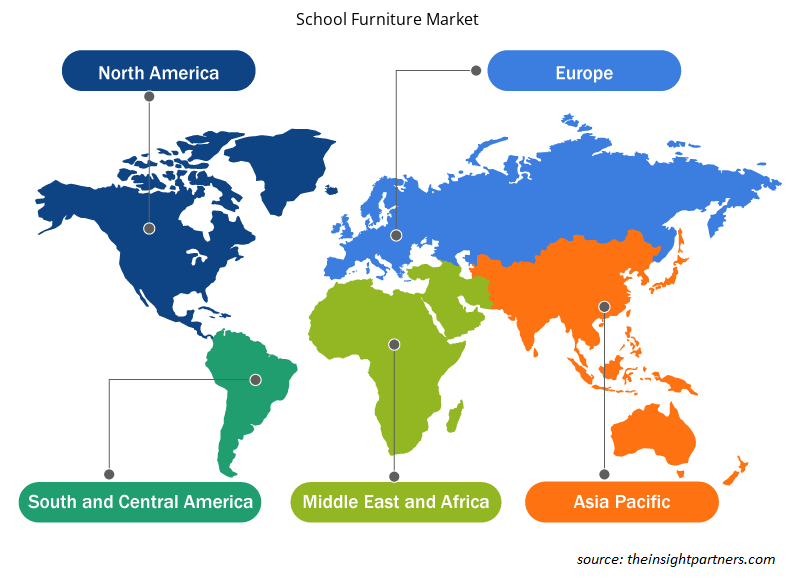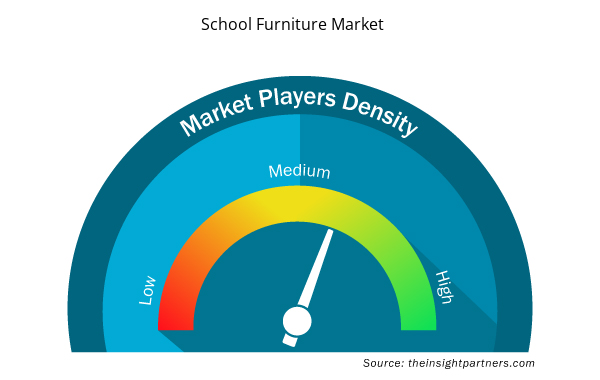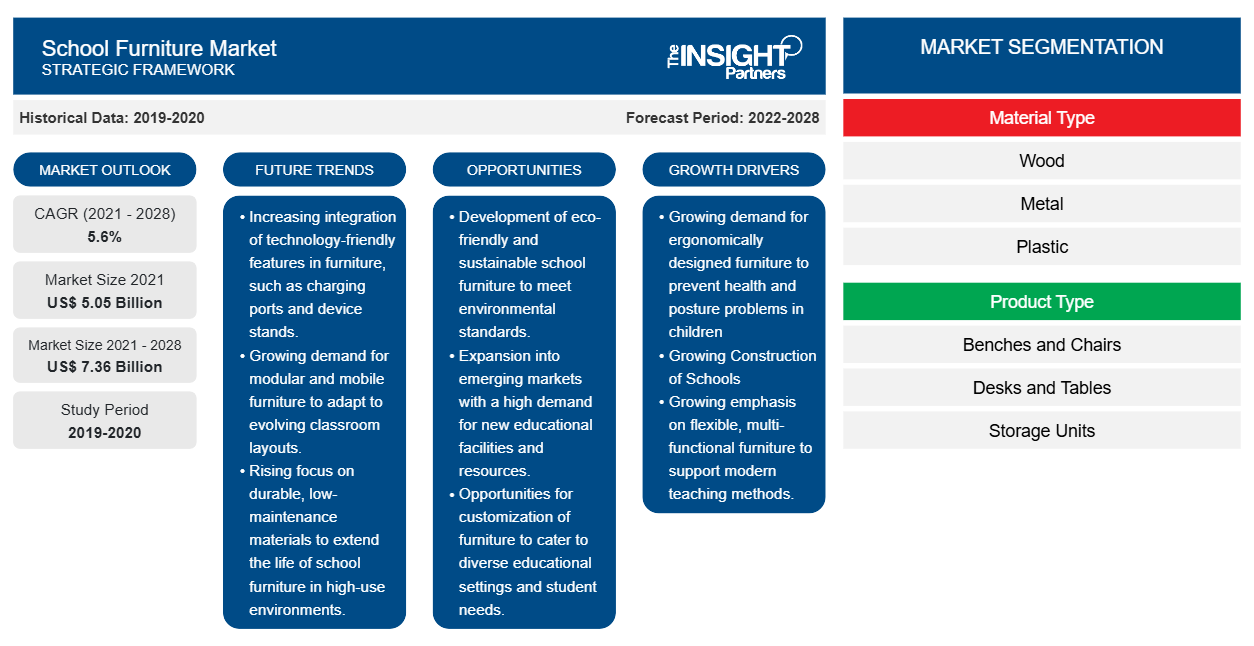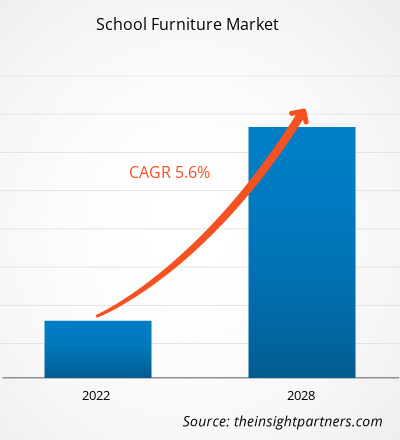[Informe de investigación] El mercado mundial de mobiliario escolar se valoró en US$ 5.047,95 millones en 2021; se espera que crezca a una CAGR del 5,6% entre 2022 y 2028.
El mobiliario escolar, que incluye estanterías, taquillas, armarios, pizarrones, escritorios, sillas, archivadores y armarios de almacenamiento, y equipos de laboratorio, se fabrica con materiales resistentes, fáciles de usar y de alta calidad, como madera, metales, tableros de fibra de densidad media (MDF) y plásticos. El mobiliario escolar está diseñado de manera que garantice el bienestar físico y mental, lo que permite a los estudiantes concentrarse en los estudios con todo su potencial. También ayuda a mejorar la flexibilidad y la productividad general de los profesores y los estudiantes, al tiempo que transforma el espacio físico en un entorno de aprendizaje dinámico.
La creciente demanda de muebles diseñados ergonómicamente para prevenir problemas de salud y postura en los niños es el factor clave que impulsa el mercado. Crear entornos de aprendizaje que mantengan a los estudiantes concentrados y cómodos se ha convertido en uno de los principales objetivos de los educadores, lo que influye positivamente en el mercado mundial del mobiliario escolar . Con la nueva era de estilos de enseñanza integrales, interactivos y dinámicos, como el aprendizaje combinado y las aulas invertidas, se ha vuelto necesario contar con muebles portátiles y ajustables que se puedan reconfigurar fácilmente.
Personalice este informe según sus necesidades
Obtendrá personalización en cualquier informe, sin cargo, incluidas partes de este informe o análisis a nivel de país, paquete de datos de Excel, así como también grandes ofertas y descuentos para empresas emergentes y universidades.
- Obtenga las principales tendencias clave del mercado de este informe.Esta muestra GRATUITA incluirá análisis de datos, desde tendencias del mercado hasta estimaciones y pronósticos.
Además, se están introduciendo varias materias primas para la producción de muebles, y estos materiales distintos han demostrado ser más sostenibles, duraderos y estables que los tradicionales, lo que añade impulso al crecimiento del mercado. Los productores utilizan materiales como madera procesada o de ingeniería, plástico moldeado y laminado de alta presión para fabricar bancos, sillas y mesas para aulas y escuelas. Los muebles con opciones de almacenamiento adicionales actúan como una táctica de ahorro de espacio en aulas más pequeñas y compactas, y la demanda de los mismos ha observado un aumento significativo en los últimos años. Por ejemplo, CBT Supply Dba Smartdesks produce mesas y sillas inteligentes con opciones apilables y aplicaciones multifuncionales para aulas y oficinas. Por lo tanto, la creciente demanda de muebles flexibles impulsará el crecimiento del mercado durante el período de pronóstico.
Perspectivas del mercado
Creciente construcción de escuelas
Se espera que la construcción de escuelas en todo el mundo aumente debido al rápido crecimiento de la población. El creciente enfoque en el sector educativo en las áreas urbanas y rurales y los esquemas de educación primaria obligatoria proporcionados por los gobiernos de todo el mundo están impulsando el crecimiento de la construcción de escuelas. Según el Centro de Presupuesto y Prioridades Políticas, en 2018, alrededor de US$ 98.9 mil millones se gastaron en proyectos de infraestructura educativa en América del Norte, lo que indica un aumento del gasto de casi el 10% desde 2017. Con el aumento de las instalaciones escolares, las aulas superpobladas, los cambios en los códigos de seguridad de la construcción y los avances tecnológicos a nivel mundial, los funcionarios se enfrentan al dilema de invertir en nueva infraestructura o modernizar las existentes. Los gobiernos y las sociedades de todo el mundo se esfuerzan por desarrollar sus sistemas educativos y garantizar que todos los estudiantes tengan la oportunidad de ir a la escuela y adquirir las habilidades y el conocimiento necesarios para llevar una vida productiva y saludable. Para mejorar la calidad educativa, se debe modernizar la infraestructura educativa.
Además, el aumento de la matrícula de estudiantes en todo el mundo ha impulsado la demanda de mesas y sillas para las aulas, ya que son necesarias para el funcionamiento de las escuelas. El aumento de la adopción de materias primas no convencionales para el mobiliario de las aulas está dando lugar a renovaciones, colaboraciones y mobiliario ergonómico para las aulas. Varias escuelas están sustituyendo progresivamente el mobiliario escolar tradicional por una infraestructura estéticamente atractiva para hacer agradable el entorno del aula. La introducción de sillas giratorias con características ergonómicas ha sido una incorporación reciente en muchas escuelas.
Información sobre el tipo de material
Según el tipo de material, el mercado del mobiliario escolar se segmenta en madera, metal, plástico y otros. En 2021, el segmento de madera dominó el mercado del mobiliario escolar.
Fleetwood Furniture, Herman Miller, Inc., KI, Steelcase Inc., Virco, Inc., Scholar Craft, Global Furniture Group, Educan, Ven-Rez y Mitybilt se encuentran entre los actores clave que operan en el mercado del mobiliario escolar. Los principales actores están adoptando diversas estrategias, como fusiones y adquisiciones y lanzamientos de productos, para expandir su presencia geográfica y su base de consumidores.
Informe Destacado
- Tendencias progresistas en la industria del mobiliario escolar para ayudar a los actores a desarrollar estrategias efectivas a largo plazo
- Estrategias de crecimiento empresarial adoptadas por las empresas para asegurar el crecimiento en los mercados desarrollados y en desarrollo
- Análisis cuantitativo del mercado de mobiliario escolar de 2021 a 2028
- Estimación de la demanda de mobiliario escolar en diversas industrias
- Análisis PEST para analizar los cambios políticos, económicos, socioculturales y tecnológicos en el entorno empresarial.
- Desarrollos recientes para comprender el escenario competitivo del mercado y la demanda de mobiliario escolar
- Tendencias y perspectivas del mercado junto con los factores que impulsan y restringen el crecimiento del mercado del mobiliario escolar
- Estrategias que sustentan el interés comercial en relación al crecimiento del mercado de mobiliario escolar, ayudando en el proceso de toma de decisiones
- El tamaño del mercado de mobiliario escolar en varios nodos del mercado
- Descripción detallada y segmentación del mercado de mobiliario escolar, así como su dinámica industrial.
El "Pronóstico del mercado de mobiliario escolar hasta 2028" es un estudio especializado y profundo de la industria de productos químicos y materiales, que se centra en el análisis de las tendencias del mercado de mobiliario escolar. El informe tiene como objetivo proporcionar una descripción general del mercado con una segmentación detallada del mercado. El mercado de mobiliario escolar se clasifica en función del tipo de material, el tipo de producto y el canal de distribución. Según el tipo de material, el mercado se segmenta en madera, metal, plástico y otros. Según el tipo de producto, el mercado se bifurca en residencial y comercial e industrial. En términos de canal de distribución, el mercado se divide en tiendas especializadas, venta minorista en línea y contratos/licitaciones.
Perspectivas regionales del mercado del mobiliario escolar
Los analistas de Insight Partners explicaron en detalle las tendencias y los factores regionales que influyen en el mercado de mobiliario escolar durante el período de pronóstico. Esta sección también analiza los segmentos y la geografía del mercado de mobiliario escolar en América del Norte, Europa, Asia Pacífico, Oriente Medio y África, y América del Sur y Central.

- Obtenga datos regionales específicos para el mercado de mobiliario escolar
Alcance del informe sobre el mercado de mobiliario escolar
| Atributo del informe | Detalles |
|---|---|
| Tamaño del mercado en 2021 | 5.050 millones de dólares estadounidenses |
| Tamaño del mercado en 2028 | 7.360 millones de dólares estadounidenses |
| CAGR global (2021-2028) | 5,6% |
| Datos históricos | 2019-2020 |
| Período de pronóstico | 2022-2028 |
| Segmentos cubiertos | Por tipo de material
|
| Regiones y países cubiertos | América del norte
|
| Líderes del mercado y perfiles de empresas clave |
|
Densidad de actores del mercado de mobiliario escolar: comprensión de su impacto en la dinámica empresarial
El mercado de mobiliario escolar está creciendo rápidamente, impulsado por la creciente demanda de los usuarios finales debido a factores como la evolución de las preferencias de los consumidores, los avances tecnológicos y una mayor conciencia de los beneficios del producto. A medida que aumenta la demanda, las empresas amplían sus ofertas, innovan para satisfacer las necesidades de los consumidores y aprovechan las tendencias emergentes, lo que impulsa aún más el crecimiento del mercado.
La densidad de actores del mercado se refiere a la distribución de las empresas o firmas que operan dentro de un mercado o industria en particular. Indica cuántos competidores (actores del mercado) están presentes en un espacio de mercado determinado en relación con su tamaño o valor total de mercado.
Las principales empresas que operan en el mercado de mobiliario escolar son:
- Muebles Fleetwood
- Herman Miller, Inc.
- KI
- Fabricante: Steelcase Inc.
- Virco, Inc.
Descargo de responsabilidad : Las empresas enumeradas anteriormente no están clasificadas en ningún orden particular.

- Obtenga una descripción general de los principales actores clave del mercado de mobiliario escolar
Perfiles de empresas
- Muebles Fleetwood
- Herman Miller, Inc
- KI
- Fabricante: Steelcase Inc.
- Virco, Inc.
- Artesanía académica
- Grupo de muebles global
- Educar
- Ven-Rez
- Mitybilt
- Análisis histórico (2 años), año base, pronóstico (7 años) con CAGR
- Análisis PEST y FODA
- Tamaño del mercado Valor/volumen: global, regional, nacional
- Industria y panorama competitivo
- Conjunto de datos de Excel



Report Coverage
Revenue forecast, Company Analysis, Industry landscape, Growth factors, and Trends

Segment Covered
This text is related
to segments covered.

Regional Scope
North America, Europe, Asia Pacific, Middle East & Africa, South & Central America

Country Scope
This text is related
to country scope.
Preguntas frecuentes
The major players operating in the global school furniture market are Fleetwood Furniture; Herman Miller, Inc; KI; Steelcase Inc.; Virco, Inc.; Scholar Craft; Global Furniture Group; Educan; Ven-Rez; and Mitybilt.
In 2021, North America held the largest share of the global school furniture market. The rise in the educational infrastructure would cater the demand of school furniture in the region. The region is also flourishing owing to presence of manufacturing facilities.
The wood segment held the largest market share. Wooden furniture is the most popular in schools, owing to the high manufacturing output of wooden products in comparison to other materials. Moreover, wood is conventionally looked at as the most preferred material for furniture production.
The benches and chairs segment held the largest market share. School chairs vary in design and are primarily made of wood, metal, and synthetic plastic materials. Folding chairs, rocking chairs, loungers, and many others are quite popular among customers.
Asia Pacific is estimated to register the fastest CAGR in the global school furniture market over the forecast period. Many Asia Pacific countries, such as China and India, are the world's fastest-growing populations. With a growing population construction and school furniture material are growing rapidly in Asia Pacific.
The contracts/bids segment held the largest share of the market in 2021. Most of the schools organize bids for school furniture. The companies can be given a contract for vendor ship, replacement, or repair based on the contract signed between the schools and them.
Trends and growth analysis reports related to Consumer Goods : READ MORE..
The List of Companies - School Furniture Market
- Fleetwood Furniture
- Herman Miller, Inc.
- KI
- Steelcase Inc.
- Virco, Inc.
- Scholar Craft
- Global Furniture Group
- Educan
- Ven-Rez
- Mitybilt
The Insight Partners performs research in 4 major stages: Data Collection & Secondary Research, Primary Research, Data Analysis and Data Triangulation & Final Review.
- Data Collection and Secondary Research:
As a market research and consulting firm operating from a decade, we have published and advised several client across the globe. First step for any study will start with an assessment of currently available data and insights from existing reports. Further, historical and current market information is collected from Investor Presentations, Annual Reports, SEC Filings, etc., and other information related to company’s performance and market positioning are gathered from Paid Databases (Factiva, Hoovers, and Reuters) and various other publications available in public domain.
Several associations trade associates, technical forums, institutes, societies and organization are accessed to gain technical as well as market related insights through their publications such as research papers, blogs and press releases related to the studies are referred to get cues about the market. Further, white papers, journals, magazines, and other news articles published in last 3 years are scrutinized and analyzed to understand the current market trends.
- Primary Research:
The primarily interview analysis comprise of data obtained from industry participants interview and answers to survey questions gathered by in-house primary team.
For primary research, interviews are conducted with industry experts/CEOs/Marketing Managers/VPs/Subject Matter Experts from both demand and supply side to get a 360-degree view of the market. The primary team conducts several interviews based on the complexity of the markets to understand the various market trends and dynamics which makes research more credible and precise.
A typical research interview fulfils the following functions:
- Provides first-hand information on the market size, market trends, growth trends, competitive landscape, and outlook
- Validates and strengthens in-house secondary research findings
- Develops the analysis team’s expertise and market understanding
Primary research involves email interactions and telephone interviews for each market, category, segment, and sub-segment across geographies. The participants who typically take part in such a process include, but are not limited to:
- Industry participants: VPs, business development managers, market intelligence managers and national sales managers
- Outside experts: Valuation experts, research analysts and key opinion leaders specializing in the electronics and semiconductor industry.
Below is the breakup of our primary respondents by company, designation, and region:

Once we receive the confirmation from primary research sources or primary respondents, we finalize the base year market estimation and forecast the data as per the macroeconomic and microeconomic factors assessed during data collection.
- Data Analysis:
Once data is validated through both secondary as well as primary respondents, we finalize the market estimations by hypothesis formulation and factor analysis at regional and country level.
- Macro-Economic Factor Analysis:
We analyse macroeconomic indicators such the gross domestic product (GDP), increase in the demand for goods and services across industries, technological advancement, regional economic growth, governmental policies, the influence of COVID-19, PEST analysis, and other aspects. This analysis aids in setting benchmarks for various nations/regions and approximating market splits. Additionally, the general trend of the aforementioned components aid in determining the market's development possibilities.
- Country Level Data:
Various factors that are especially aligned to the country are taken into account to determine the market size for a certain area and country, including the presence of vendors, such as headquarters and offices, the country's GDP, demand patterns, and industry growth. To comprehend the market dynamics for the nation, a number of growth variables, inhibitors, application areas, and current market trends are researched. The aforementioned elements aid in determining the country's overall market's growth potential.
- Company Profile:
The “Table of Contents” is formulated by listing and analyzing more than 25 - 30 companies operating in the market ecosystem across geographies. However, we profile only 10 companies as a standard practice in our syndicate reports. These 10 companies comprise leading, emerging, and regional players. Nonetheless, our analysis is not restricted to the 10 listed companies, we also analyze other companies present in the market to develop a holistic view and understand the prevailing trends. The “Company Profiles” section in the report covers key facts, business description, products & services, financial information, SWOT analysis, and key developments. The financial information presented is extracted from the annual reports and official documents of the publicly listed companies. Upon collecting the information for the sections of respective companies, we verify them via various primary sources and then compile the data in respective company profiles. The company level information helps us in deriving the base number as well as in forecasting the market size.
- Developing Base Number:
Aggregation of sales statistics (2020-2022) and macro-economic factor, and other secondary and primary research insights are utilized to arrive at base number and related market shares for 2022. The data gaps are identified in this step and relevant market data is analyzed, collected from paid primary interviews or databases. On finalizing the base year market size, forecasts are developed on the basis of macro-economic, industry and market growth factors and company level analysis.
- Data Triangulation and Final Review:
The market findings and base year market size calculations are validated from supply as well as demand side. Demand side validations are based on macro-economic factor analysis and benchmarks for respective regions and countries. In case of supply side validations, revenues of major companies are estimated (in case not available) based on industry benchmark, approximate number of employees, product portfolio, and primary interviews revenues are gathered. Further revenue from target product/service segment is assessed to avoid overshooting of market statistics. In case of heavy deviations between supply and demand side values, all thes steps are repeated to achieve synchronization.
We follow an iterative model, wherein we share our research findings with Subject Matter Experts (SME’s) and Key Opinion Leaders (KOLs) until consensus view of the market is not formulated – this model negates any drastic deviation in the opinions of experts. Only validated and universally acceptable research findings are quoted in our reports.
We have important check points that we use to validate our research findings – which we call – data triangulation, where we validate the information, we generate from secondary sources with primary interviews and then we re-validate with our internal data bases and Subject matter experts. This comprehensive model enables us to deliver high quality, reliable data in shortest possible time.


 Obtenga una muestra gratuita de este informe
Obtenga una muestra gratuita de este informe